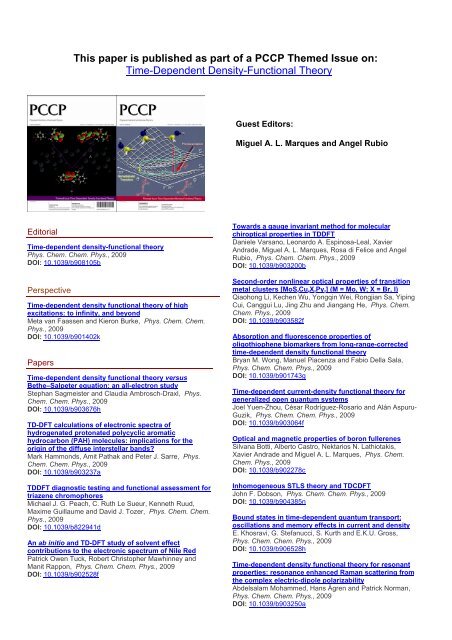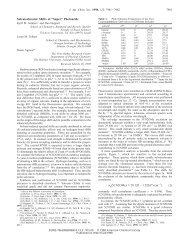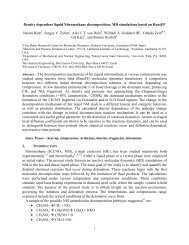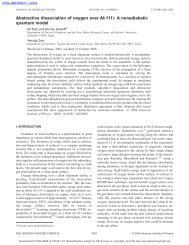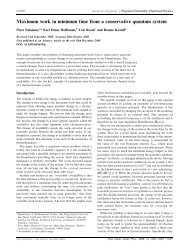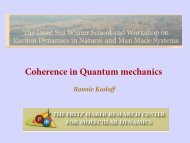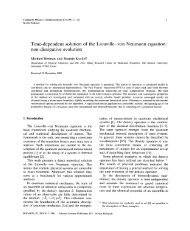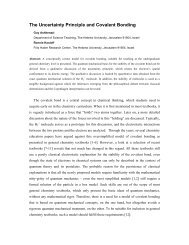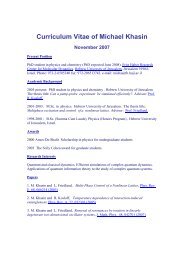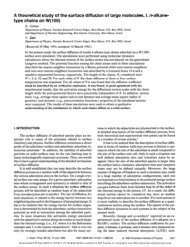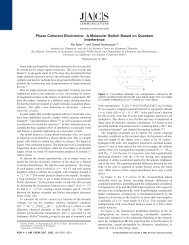Time-Dependent Density-Functional Theory - The Fritz Haber ...
Time-Dependent Density-Functional Theory - The Fritz Haber ...
Time-Dependent Density-Functional Theory - The Fritz Haber ...
Create successful ePaper yourself
Turn your PDF publications into a flip-book with our unique Google optimized e-Paper software.
Editorial<br />
This paper is published as part of a PCCP <strong>The</strong>med Issue on:<br />
<strong>Time</strong>-<strong>Dependent</strong> <strong>Density</strong>-<strong>Functional</strong> <strong><strong>The</strong>ory</strong><br />
<strong>Time</strong>-dependent density-functional theory<br />
Phys. Chem. Chem. Phys., 2009<br />
DOI: 10.1039/b908105b<br />
Perspective<br />
<strong>Time</strong>-dependent density functional theory of high<br />
excitations: to infinity, and beyond<br />
Meta van Faassen and Kieron Burke, Phys. Chem. Chem.<br />
Phys., 2009<br />
DOI: 10.1039/b901402k<br />
Papers<br />
<strong>Time</strong>-dependent density functional theory versus<br />
Bethe–Salpeter equation: an all-electron study<br />
Stephan Sagmeister and Claudia Ambrosch-Draxl, Phys.<br />
Chem. Chem. Phys., 2009<br />
DOI: 10.1039/b903676h<br />
TD-DFT calculations of electronic spectra of<br />
hydrogenated protonated polycyclic aromatic<br />
hydrocarbon (PAH) molecules: implications for the<br />
origin of the diffuse interstellar bands?<br />
Mark Hammonds, Amit Pathak and Peter J. Sarre, Phys.<br />
Chem. Chem. Phys., 2009<br />
DOI: 10.1039/b903237a<br />
TDDFT diagnostic testing and functional assessment for<br />
triazene chromophores<br />
Michael J. G. Peach, C. Ruth Le Sueur, Kenneth Ruud,<br />
Maxime Guillaume and David J. Tozer, Phys. Chem. Chem.<br />
Phys., 2009<br />
DOI: 10.1039/b822941d<br />
An ab initio and TD-DFT study of solvent effect<br />
contributions to the electronic spectrum of Nile Red<br />
Patrick Owen Tuck, Robert Christopher Mawhinney and<br />
Manit Rappon, Phys. Chem. Chem. Phys., 2009<br />
DOI: 10.1039/b902528f<br />
Guest Editors:<br />
Miguel A. L. Marques and Angel Rubio<br />
Towards a gauge invariant method for molecular<br />
chiroptical properties in TDDFT<br />
Daniele Varsano, Leonardo A. Espinosa-Leal, Xavier<br />
Andrade, Miguel A. L. Marques, Rosa di Felice and Angel<br />
Rubio, Phys. Chem. Chem. Phys., 2009<br />
DOI: 10.1039/b903200b<br />
Second-order nonlinear optical properties of transition<br />
metal clusters [MoS 4Cu 4X 2Py 2] (M = Mo, W; X = Br, I)<br />
Qiaohong Li, Kechen Wu, Yongqin Wei, Rongjian Sa, Yiping<br />
Cui, Canggui Lu, Jing Zhu and Jiangang He, Phys. Chem.<br />
Chem. Phys., 2009<br />
DOI: 10.1039/b903582f<br />
Absorption and fluorescence properties of<br />
oligothiophene biomarkers from long-range-corrected<br />
time-dependent density functional theory<br />
Bryan M. Wong, Manuel Piacenza and Fabio Della Sala,<br />
Phys. Chem. Chem. Phys., 2009<br />
DOI: 10.1039/b901743g<br />
<strong>Time</strong>-dependent current-density functional theory for<br />
generalized open quantum systems<br />
Joel Yuen-Zhou, César Rodríguez-Rosario and Alán Aspuru-<br />
Guzik, Phys. Chem. Chem. Phys., 2009<br />
DOI: 10.1039/b903064f<br />
Optical and magnetic properties of boron fullerenes<br />
Silvana Botti, Alberto Castro, Nektarios N. Lathiotakis,<br />
Xavier Andrade and Miguel A. L. Marques, Phys. Chem.<br />
Chem. Phys., 2009<br />
DOI: 10.1039/b902278c<br />
Inhomogeneous STLS theory and TDCDFT<br />
John F. Dobson, Phys. Chem. Chem. Phys., 2009<br />
DOI: 10.1039/b904385n<br />
Bound states in time-dependent quantum transport:<br />
oscillations and memory effects in current and density<br />
E. Khosravi, G. Stefanucci, S. Kurth and E.K.U. Gross,<br />
Phys. Chem. Chem. Phys., 2009<br />
DOI: 10.1039/b906528h<br />
<strong>Time</strong>-dependent density functional theory for resonant<br />
properties: resonance enhanced Raman scattering from<br />
the complex electric-dipole polarizability<br />
Abdelsalam Mohammed, Hans Ågren and Patrick Norman,<br />
Phys. Chem. Chem. Phys., 2009<br />
DOI: 10.1039/b903250a
On the proton transfer mechanism in ammonia-bridged<br />
7-hydroxyquinoline: a TDDFT molecular dynamics study<br />
Matteo Guglielmi, Ivano Tavernelli and Ursula<br />
Rothlisberger, Phys. Chem. Chem. Phys., 2009<br />
DOI: 10.1039/b903136g<br />
Chemical and protein shifts in the spectrum of the<br />
photoactive yellow protein: a time-dependent density<br />
functional theory/molecular mechanics study<br />
Eneritz Muguruza González, Leonardo Guidoni and Carla<br />
Molteni, Phys. Chem. Chem. Phys., 2009<br />
DOI: 10.1039/b902615k<br />
Excitation energies from ground-state densityfunctionals<br />
by means of generator coordinates<br />
E. Orestes, A. B. F. da Silva and K. Capelle, Phys. Chem.<br />
Chem. Phys., 2009<br />
DOI: 10.1039/b902529d<br />
A time-dependent density-functional approach to<br />
nonadiabatic electron-nucleus dynamics: formulation<br />
and photochemical application<br />
Hirotoshi Hirai and Osamu Sugino, Phys. Chem. Chem.<br />
Phys., 2009<br />
DOI: 10.1039/b901144g<br />
Wavepacket basis for time-dependent processes and its<br />
application to relaxation in resonant electronic transport<br />
Peter Bokes, Phys. Chem. Chem. Phys., 2009<br />
DOI: 10.1039/b902501d<br />
Can phthalocyanines and their substituted -para-<br />
(methoxy)phenyl derivatives act as photosensitizers in<br />
photodynamic therapy? A TD-DFT study<br />
Angelo Domenico Quartarolo, Ida Lanzo, Emilia Sicilia and<br />
Nino Russo, Phys. Chem. Chem. Phys., 2009<br />
DOI: 10.1039/b819064j<br />
Substituent effects on the light-induced C–C and C–Br<br />
bond activation in (bisphosphine)( 2 -tolane)Pt 0<br />
complexes. A TD-DFT study<br />
Daniel Escudero, Mariana Assmann, Anne Pospiech,<br />
Wolfgang Weigand and Leticia González, Phys. Chem.<br />
Chem. Phys., 2009<br />
DOI: 10.1039/b903603b<br />
Photodegradation mechanism of the common nonsteroid<br />
anti-inflammatory drug diclofenac and its<br />
carbazole photoproduct<br />
Klefah A. K. Musa and Leif A. Eriksson, Phys. Chem. Chem.<br />
Phys., 2009<br />
DOI: 10.1039/b900144a<br />
Computation of accurate excitation energies for large<br />
organic molecules with double-hybrid density<br />
functionals<br />
Lars Goerigk, Jonas Moellmann and Stefan Grimme, Phys.<br />
Chem. Chem. Phys., 2009<br />
DOI: 10.1039/b902315a<br />
<strong>Time</strong>-dependent current density functional theory via<br />
time-dependent deformation functional theory: a<br />
constrained search formulation in the time domain<br />
I. V. Tokatly, Phys. Chem. Chem. Phys., 2009<br />
DOI: 10.1039/b903666k<br />
Photoabsorption spectra from adiabatically exact timedependent<br />
density-functional theory in real time<br />
Mark Thiele and Stephan Kümmel, Phys. Chem. Chem.<br />
Phys., 2009<br />
DOI: 10.1039/b902567g<br />
Double excitation effect in non-adiabatic time-dependent<br />
density functional theory with an analytic construction<br />
of the exchange–correlation kernel in the common<br />
energy denominator approximation<br />
Oleg V. Gritsenko and Evert Jan Baerends, Phys. Chem.<br />
Chem. Phys., 2009<br />
DOI: 10.1039/b903123e<br />
Physical signatures of discontinuities of the timedependent<br />
exchange–correlation potential<br />
Daniel Vieira, K. Capelle and C. A. Ullrich, Phys. Chem.<br />
Chem. Phys., 2009<br />
DOI: 10.1039/b902613d<br />
Autoionizing resonances in time-dependent density<br />
functional theory<br />
August J. Krueger and Neepa T. Maitra, Phys. Chem.<br />
Chem. Phys., 2009<br />
DOI: 10.1039/b902787d<br />
<strong>The</strong> polarizability in solution of tetra-phenyl-porphyrin<br />
derivatives in their excited electronic states: a PCM/TD-<br />
DFT study<br />
Roberto Improta, Camilla Ferrante, Renato Bozio and<br />
Vincenzo Barone, Phys. Chem. Chem. Phys., 2009<br />
DOI: 10.1039/b902521a<br />
A new generalized Kohn–Sham method for fundamental<br />
band-gaps in solids<br />
Helen R. Eisenberg and Roi Baer, Phys. Chem. Chem.<br />
Phys., 2009<br />
DOI: 10.1039/b902589h
PAPER www.rsc.org/pccp | Physical Chemistry Chemical Physics<br />
A new generalized Kohn–Sham method for fundamental<br />
band-gaps in solids<br />
Helen R. Eisenberg and Roi Baer*<br />
Received 9th February 2009, Accepted 20th April 2009<br />
First published as an Advance Article on the web 5th May 2009<br />
DOI: 10.1039/b902589h<br />
We developed a method for calculating the ground-state properties and fundamental band-gaps of<br />
solids, using a generalized Kohn–Sham approach combining a local density approximation (LDA)<br />
functional with a long-range explicit exchange orbital functional. We found that when the range<br />
parameter is selected according to the formula g = A/(eN ~e) where eN is the optical dielectric<br />
constant of the solid and ~e = 0.84 and A = 0.216 a0 1 , predictions of the fundamental band-gap<br />
close to the experimental values are obtained for a variety of solids of different types. For most<br />
solids the range parameter g is small (i.e. explicit exchange is needed only at long distances) so the<br />
predicted values for lattice constants and bulk moduli are similar to those based on conventional<br />
LDA calculations. Preliminary calculations on silicon give a general band structure in good<br />
agreement with experiment.<br />
I. Introduction<br />
<strong>Density</strong> functional theory (DFT), 1 applied via the Kohn–Sham<br />
(KS) approach, 2 is routinely used for the successful determination<br />
and interpretation of the structural and cohesive<br />
properties of a broad variety of solid state systems. However,<br />
solid-state band-gaps are typically underestimated by a factor<br />
of 2. In the KS approach the system of electrons is mapped onto<br />
a system of non-interacting fermions (the KS system) governed<br />
by a local potential (in practical calculations this local potential<br />
is only approximately known). In this non-interacting system a<br />
one-particle Schrödinger equation is set up and its eigenstates<br />
and eigenvalues (called KS orbital energies) are determined.<br />
<strong>The</strong> lowest orbital energies are then used as estimates for<br />
ionization potentials. However, such a procedure is only known<br />
to be rigorously correct for the Fermi level. 3,4 <strong>The</strong> fundamental<br />
band-gap of the solid, Eg, is often approximated by the<br />
Kohn–Sham band-gap (the difference between the bottom of<br />
the conduction band and the top of the valence band).<br />
However, this too is unjustified. For a system of N electrons<br />
the fundamental band-gap is a ground state quantity in the sense<br />
that it can be expressed in terms of the ground-state energies, E gs,<br />
of the N 1, N and N + 1 electron systems as follows:<br />
Eg ¼ IP EA<br />
¼ lim<br />
N!1 EgsðN 1Þ 2EgsðNÞþEgsðN þ 1Þ<br />
ð1:1Þ<br />
where IP is the ionization potential and EA the electron<br />
affinity. For a finite electron system the band-gap can be<br />
computed by considering the KS systems of N and N + 1<br />
particles and can be expressed as follows:<br />
Eg = eN,N + eN +1,N+1<br />
=(eN,N+1 eN,N) +DXC (1.2)<br />
Institute of Chemistry and the <strong>Fritz</strong> <strong>Haber</strong> Center for Molecular<br />
Dynamics, <strong>The</strong> Hebrew University of Jerusalem, Jerusalem 91904,<br />
Israel. E-mail: roi.baer@huji.ac.il<br />
Where eN,M is the Mth KS orbital energy of the N-particle KS<br />
system and DXC = eN + 1,N + 1 eN,N+1 is called the<br />
derivative discontinuity (because it does not go to zero in<br />
the N - N limit) and the term in parentheses is the KS<br />
band-gap. Evidently, even if the exact local potential of the<br />
KS systems was known, the common procedure of taking the<br />
KS band-gap would not give the correct solid-state gap as one<br />
would still need to add to the orbital gap the derivative<br />
discontinuity DXC. 5–7<br />
<strong>The</strong> popular local and semi-local approximations, such as<br />
the local density approximation (LDA) and the generalized<br />
gradients approximations (GGAs), are believed to give local<br />
potentials and orbital energies which are not bad approximations<br />
to the exact KS quantities. 8 However, because of their<br />
inherent semi-local density structure, they predict a zero derivative<br />
discontinuity (DXC =0). 5 <strong>The</strong>refore, the fundamental bandgaps<br />
inferred from them, are similar to the exact Kohn–Sham<br />
band gaps but are poor approximations to the experimental<br />
gaps (by a factor of B2). <strong>The</strong> fact that derivative discontinuities<br />
are missing from semi-local functionals has been associated with<br />
the existence of spurious electron self-repulsion. 5,9,10<br />
<strong>The</strong> complication of adding the derivative discontinuity to<br />
the KS band can be circumvented in the generalized<br />
Kohn–Sham (GKS) framework 11 which uses explicit orbital<br />
functionals (i.e. the orbitals are explicitly contained in the<br />
functional as opposed to the functional being only explicitly<br />
dependent on the density). With explicit orbital functionals,<br />
the orbital energy band-gap already incorporates some or all<br />
of the derivative discontinuity and so may be used to directly<br />
approximate the experimental band-gap. For example, if the<br />
orbital functional includes a Hartree–Fock like exchange<br />
operator the derivative discontinuity DXC can be decomposed<br />
into the sum of corresponding exchange (DX) and correlation<br />
(DC) parts. It was demonstrated, using perturbative arguments,<br />
that the orbital energy gap in the GKS equation<br />
incorporates much of DX while the correlation derivative<br />
discontinuity DC was estimated as a much smaller correction. 11<br />
4674 | Phys. Chem. Chem. Phys., 2009, 11, 4674–4680 This journal is c the Owner Societies 2009
<strong>The</strong>re are several previous works which use a generalized<br />
KS framework for band-gaps. One approach splits the exchange<br />
energy into an explicit short-range exchange operator and a<br />
local functional for the long-range exchange. 11–13 This resulted<br />
in significant improvements over the LDA fundamental bandgap<br />
for some of the materials studied. A similar approach was<br />
applied using the HSE functional with much improved<br />
results, probably due to the use of more advanced semi-local<br />
exchange–correlation functionals. 14 Both these approaches are<br />
not expected to include the entire exchange discontinuity DX<br />
because the orbital functional they use does not include a longrange<br />
self-repulsion correction. <strong>The</strong>refore, one cannot expect<br />
the fundamental band-gap to be fully contained in their GKS<br />
orbital gap. This problem can be fixed by using an explicit<br />
exchange operator for the long-range (instead of the short<br />
range) part of the exchange. This might thus be a more<br />
appropriate way to circumvent the derivative discontinuity<br />
contribution. Such an attempt was reported recently but huge<br />
gaps were found for most materials. 15<br />
In this work we present a generalized Kohn–Sham method<br />
which deploys an explicit orbital exchange that incorporates<br />
the long-range self-repulsion correction exactly. <strong>The</strong> procedure<br />
introduces into the DFT correlation energy expression<br />
a short-range but non-local exchange-like orbital functional<br />
which eliminates the detrimental effects of the full<br />
‘‘Hartree–Fock-like’’ exchange. 16–19 In this sense our approach<br />
is similar to that of ref. 15. <strong>The</strong> crucial difference is that here<br />
the range-parameter g is not considered ‘‘universal’’. It depends<br />
on the density of the system and must be tuned separately for<br />
each system. 19–22 We show how such a ‘‘tuning’’ can be done<br />
for solid state systems: the range-parameter g was found<br />
empirically to correlate very well with the optical dielectric<br />
constant eN of the solid. Based on this relation we developed a<br />
method that describes the usual ground-state properties of<br />
solids (lattice parameter and bulk modulus) with LDA quality<br />
while simultaneously describing the fundamental band-gaps<br />
extremely well.<br />
Our theory for the range-separated hybrid is discussed in<br />
section II. <strong>The</strong> relation between the range parameter and the<br />
dielectric constant is the topic of section III. <strong>The</strong> performance<br />
of the method is demonstrated in section IV followed by<br />
summary and discussion in section V.<br />
II. <strong>The</strong> range-separated hybrid functional<br />
In the Kohn–Sham approach DFT the ground-state energy of<br />
a system of Ne electrons in an external potential u(r), with<br />
particle-density n(r) and a many-electron wave function cgs is<br />
expressed using quantities calculated for a system of<br />
non-interacting fermions with an identical ground-state<br />
density. <strong>The</strong> wave function of this ‘‘non-interacting’’ system<br />
is a Slater determinant and is denoted by cS. 2 Both wave<br />
functions, c gs and c S are unique (up to global phase) functionals<br />
of the density. <strong>The</strong> energy of the interacting system is<br />
written as:<br />
E = hc gs|Hˆ |c gsi = hc S|Hˆ |c Si + E C[n] (2.1)<br />
where Hˆ =Tˆ +Vˆ +Uˆ is the Hamiltonian of the interacting<br />
system and ^T ¼ P Ne<br />
n ¼ 1<br />
1<br />
2 r2 n , ^V ¼ P Ne<br />
n¼1 u ðrnÞ and<br />
^U ¼ 1 PNe 2 nam 1 are, respectively, the kinetic energy, the inter-<br />
rnm<br />
action with the external potential and the electron Coulomb<br />
repulsion operators (in atomic units). <strong>The</strong> last term EC|n| is the<br />
negative correlation energy functional which, because the two<br />
systems have the same density, can be written as:<br />
E C[n] =hc gs|Tˆ + Uˆ |c gsi hc S|Tˆ + Uˆ |c Si (2.2)<br />
As we explain below, there exists a g for which the correlation<br />
energy can also be expressed as: 19<br />
E C[n] =hc gs|Yˆ g|c gsi hc S|Yˆ g|c Si (2.3)<br />
where Yˆ g is a shielded Coulomb interaction energy:<br />
^Y g ¼ 1 X<br />
ygðjrn<br />
2<br />
rmjÞ ð2:4Þ<br />
nam<br />
With the pair potential:<br />
erfcðgrÞ ygðrÞ ¼<br />
r<br />
r40 ð2:5Þ<br />
This function has the properties that lim ygðrÞ ¼0 and<br />
g!1<br />
y0ðrÞ ¼1 r , which can be used to show that for each groundstate<br />
density n(r) there exists a g for which eqn (2.3) holds<br />
exactly. 19<br />
Even when g is known expression (2.3) is not practical for<br />
calculations since we have no access to cgs. We thus follow the<br />
spirit of the local density approximation and approximate it as:<br />
E Hyb<br />
C [n] = R f g<br />
XC(n(r))d 3 r<br />
R<br />
|r(r1,r2)| 2 yg(|r1 r2|)d 3 r1d 3 r2 (2.6)<br />
+ 1<br />
2<br />
in which r(r 1,r 2) is the density matrix of the non-interacting<br />
system and<br />
f g XC(n(r),|rn(r)|, ) = [e HEG<br />
C (n(r)) + e g X(n(r))]n(r) (2.7)<br />
e HEG<br />
C (n) is the correlation energy per electron of the homogeneous<br />
gas (HG) of electrons at density n and e g X is the<br />
exchange energy of the HG of particles interacting with the<br />
potential yg (r). 23 Eqn (2.6) depicts the correlation energy of<br />
DFT as a functional of the density. However, in GKS it can be<br />
considered a functional of the orbitals. This is our intention<br />
here. <strong>The</strong> details of the approach given here are described<br />
in ref. 19. We should note that similar approaches to the<br />
present method were conceived earlier 16–18,24 but view g as a<br />
‘‘universal’’ parameter that is obtained by fitting to a database<br />
of molecular properties. Recently we used a similar method to<br />
the one described here for molecules which are problematic for<br />
conventional DFT. 20 In that paper it was shown that ab-initio<br />
tuning of the range parameter is necessary in order to describe<br />
the symmetric radical cation R + R + in the ground state. 21<br />
Furthermore, range parameter tuning is also required for<br />
charge-transfer excitations. 25<br />
III. Application for solids<br />
A Technical computational details<br />
<strong>The</strong> previous section has briefly reviewed the range separated<br />
functional; we now describe its use for predicting the<br />
properties of solids. <strong>The</strong> calculations described below were<br />
This journal is c the Owner Societies 2009 Phys.Chem.Chem.Phys., 2009, 11, 4674–4680 | 4675
carried out using the Quantum-ESPRESSO package 26 which<br />
we modified to include the functional described in<br />
eqns (2.6)–(2.7). <strong>The</strong> local correlation functional used was<br />
the PZ81 LDA functional. 27 <strong>The</strong> local exchange functional is<br />
the LDA exchange of a homogeneous gas of particles interacting<br />
with the y g(r) pair potential. 16,18 All calculations used a<br />
plane-wave basis and were converged for kinetic energy cutoff<br />
for wave-functions (varied with material) and k-point grid<br />
density (4 4 4 grid was used). Calculations were carried<br />
out at the minimum energy lattice constant for each value of g.<br />
Norm-conserving pseudopotentials based on the PZ81 exchange–<br />
correlation functional were used and all the calculations were<br />
fully self-consistent.<br />
We ignored spin–orbit (SO) splitting effects when calculating<br />
the fundamental band-gap. <strong>The</strong>se effects are negligible in<br />
all the systems we studied except AlSb and to a lesser extent<br />
AlAs. Following ref. 11 the correction to the DFT calculated<br />
fundamental gap due to spin–orbit splitting is approximately<br />
DSO/3 at g (where DSO is the spin–orbit splitting energy). For<br />
AlSb this gives a SO correction of 0.23 eV (13% of the band<br />
gap) and for AlAs a SO correction of 0.09 eV (4% of the<br />
band gap). In future works we intend to investigate the effects<br />
of large SO splitting and determine whether or not corrections<br />
for this need to be included in our method.<br />
B Band-gap dependence on the range parameter<br />
As also found for molecules 20,21,25 the range parameter g in the<br />
functional must undergo a tuning stage. In order to determine<br />
a method for this we study the dependence of the fundamental<br />
gap on g by considering the following non-dimensional<br />
quantity which we call the normalized band gap:<br />
gg ¼ Eg g<br />
E1 g<br />
E0 g<br />
E 0 g<br />
; E 0 g<br />
E LDA<br />
g ; E 1 g E HF<br />
g<br />
ð3:1Þ<br />
where E g g is the gap computed with the range-separated hybrid<br />
functional with parameter g. By definition, gN = 1 and this<br />
was found to be close to the results of Hartree–Fock (HF)<br />
theory, while g 0 = 0 is the LDA limit for this equation. We<br />
plot the values of g g for several materials, diamond (C), silicon,<br />
SiC, and MgO in Fig. 1a. It can be seen that the normalized<br />
gap energy is sensitive to g for 0.01 o g o 1. <strong>The</strong> experimental<br />
band gap values typically coincide with calculated ones in the<br />
range 0.01 o g o 0.1. A different behavior is seen for the<br />
lattice constant a: it is insensitive to g when 0.01 o g o 0.1 and<br />
takes the LDA value. This is clearly seen in Fig. 1b, where the<br />
normalized lattice constant, defined by:<br />
ag ¼ ag a0 a1 ; a0<br />
a0 a LDA ; a 1 a HF<br />
ð3:2Þ<br />
is shown for SiC (other materials show similar behavior) as a<br />
function of g. Change in the lattice constant starts at g 4 0.1.<br />
We conclude that the material band-gaps are very sensitive<br />
to g in the experimentally relevant range while the lattice<br />
constants take the LDA values there. Furthermore each<br />
material requires a different value of g in order to obtain<br />
the experimental band-gap. For any given material we<br />
designate by g* the value of g for which the calculated<br />
Fig. 1 (a) <strong>The</strong> normalized band gap (eqn (3.1)) as a function of g for<br />
several materials. Direct (indirect) band gaps are denoted ‘‘dir’’<br />
(‘‘indir’’). <strong>The</strong> horizontal lines are the experimental results (exp).<br />
(b) <strong>The</strong> normalized lattice constant (eqn (3.2)) of SiC.<br />
fundamental band-gap is equal to the corresponding<br />
experimental band-gap.<br />
C <strong>The</strong> relation between c* and the dielectric constant<br />
<strong>The</strong> basic problem is to find a method for determining g*.<br />
Thus, we have to find an additional relation between g and<br />
another internal property of the solid, which can be calculated<br />
from the electronic structure. This way one can determine g*<br />
computationally without any material-dependent external<br />
input parameters.<br />
We found that a simple relation exists between g* and the<br />
optical dielectric constant eN. We plot in Fig. 2 the value of g*<br />
as a function of the experimental eN for several solids. It can<br />
be seen that the relation between g* and eN can be described<br />
approximately by a simple functional relation with two<br />
parameters A and ~e:<br />
g*ðe1Þ<br />
4676 | Phys. Chem. Chem. Phys., 2009, 11, 4674–4680 This journal is c the Owner Societies 2009<br />
A<br />
e1 ~e<br />
ð3:3Þ
Fig. 2 <strong>The</strong> value of g giving experimental fundamental band-gaps, g*,<br />
plotted against the experimental value of the optical dielectric<br />
constants eN for different materials. <strong>The</strong> line depicts the relation given<br />
in eqn (3.3) with A = 0.216 a 0 1 and ~e = 0.84.<br />
This relation will naturally give g* - 0 for metallic systems<br />
(where eN - N), therefore LDA is recovered which is appropriate<br />
for metals. In order to avoid singularities and negative<br />
values of g*, ~e must be smaller than 1 (all materials have<br />
eN Z 1). We fitted to the data the constants A =0.216a0 1<br />
and ~e = 0.84. We adopt these values as an empirical relation<br />
and use them in this study.<br />
Algorithm. <strong>The</strong> way to use eqn (3.3) in a calculation is:<br />
(1) Perform an LDA calculation to determine eN. (2) Determine g* based on eN from eqn (3.3) and perform<br />
the DFT calculation with the range-separated hybrid<br />
functional with g*.<br />
(3) Determine the band-gap by measuring the energy<br />
difference between the minimum energy of the conduction<br />
band orbital and the maximum energy of the valence band<br />
orbital.<br />
For small g the calculated dielectric constant eN does not<br />
e1 g<br />
significantly depend on g. We plotted the ratio rðgÞ ¼ ðÞ<br />
e1ð0Þ as a<br />
function of g for Si and MgO (Fig. 3). It is seen that for Si the<br />
computed eN does not change significantly from its LDA<br />
value for g o 0.05 and even until g = 0.1 the change is small<br />
(less than 6%). For MgO, the range at which eN takes the<br />
LDA value is even larger. We conclude that for materials with<br />
small g* (such as semiconductors) the proximity of the hybrid<br />
functional to LDA justifies using the LDA value of eN. For<br />
larger gap materials this may need to be checked on a case by<br />
case basis and if needed the algorithm above can be modified<br />
to include an iteration step requiring self-consistency between<br />
eN and g*.<br />
An important point to note is that semiconducting systems<br />
(which are close to metals) have very small g* values, and<br />
so the predictions of the hybrid functional concerning<br />
ground-state properties become almost identical with those<br />
of LDA. Even the large band-gap systems, such as NaCl<br />
have a value of g* smaller by more than a factor of 2<br />
than the typical values of g used for gas-phase molecules<br />
(which have g B0.5 20 ).<br />
Fig. 3 <strong>The</strong> dependence of the calculated dielectric constant on g.<br />
IV. Results<br />
Our generalized KS DFT method consists of using as a<br />
correlation functional eqns (2.6)–(2.7) with the value of g*<br />
determined by the relation (3.3). <strong>The</strong> dielectric constant in the<br />
latter equation is to be taken from the LDA calculation.<br />
However, we used the experimental dielectric constant instead<br />
in this paper (which is expected to be close to that of LDA) in<br />
order to demonstrate the concepts. We further discuss this<br />
issue later, and give a few results with calculated dielectric<br />
constants.<br />
We begin with ground-state properties: the lattice constant a<br />
and the isotropic bulk modulus B. We computed E(a), the<br />
SCF energy for several lattice constants near the optimal<br />
amin; we then fit to the resulting data a low order polynomial<br />
Ep(E) =b0 + b1E + b2E 2 + , using the polynomial for<br />
which we determined the exact value of the lattice constant<br />
a min (where E 0 p(a min) = 0)) and for the Bulk modulus we<br />
computed the 2nd derivative E 00 p(a min) from which the bulk<br />
modulus is determined by: B ¼ a2E00 p ðaminÞ 9V where V is the unit cell<br />
volume. For several materials, where anharmonic effects are<br />
significant, we noticed that the second derivative results were<br />
somewhat sensitive to the order and location of data points we<br />
used; thus we determined a confidence interval for the value of<br />
B. <strong>The</strong> results of this procedure are depicted in Table 1 where<br />
the calculation results for the lattice constants and the bulk<br />
moduli are compared with various experimental measurements.<br />
<strong>The</strong> lattice constants we computed were almost identical<br />
with those of LDA. This is a result of the very small value<br />
of g* we used, which leaves us very close to the LDA limit. As<br />
for the bulk modulus, this quantity is more sensitive to g*,<br />
however in all cases we obtained values which are in agreement<br />
(or very closely so) with experimental results. <strong>The</strong> largest<br />
discrepancy was for NaCl where our result, although too large<br />
by 20%, was somewhat better than LDA.<br />
Next we consider the fundamental band-gaps. <strong>The</strong> values<br />
of g*(eN) shown in Table 1 were used to compute the fundamental<br />
band-gaps of different materials. We found good<br />
band-gaps, as shown in Fig. 4. This is not very surprising in<br />
view of the nice fit eqn (3.3) gives for the data of g*. <strong>The</strong> only<br />
point lying significantly below the curve of Fig. 2 is that<br />
This journal is c the Owner Societies 2009 Phys.Chem.Chem.Phys., 2009, 11, 4674–4680 | 4677
Table 1 Dielectric constants, lattice constants and bulk moduli for the various solids considered in this study with comparison to experiment.<br />
LDA-g refers to the results obtained using the present method<br />
Material Symmetry Solid type e N a<br />
corresponding to AlN in the wurzite configuration (AlN(wur)).<br />
Indeed the band-gap predicted for this system deviates more<br />
significantly from the experimental band-gap than in the other<br />
systems.<br />
In all cases the band gaps, which are much too small<br />
according to LDA, were greatly improved according to the<br />
new functional. Especially encouraging is the fact that small<br />
semiconductor gaps are described as well as large ionic gaps<br />
using the simple 2-parameter formula in eqn (3.3).<br />
Experimental g*(e N) Lattice constant (a0) Bulk Modulus (GPa)<br />
(a0 1 ) LDA LDA-g Experiment b LDA LDA-g Experiment d<br />
C Diamond Insulator 5.7 0.045 6.67 6.67 6.74 580–585 510–640 440–560<br />
Si Diamond Semicond. 11.7 0.020 10.23 10.23 10.26 96–97 92 80–100<br />
SiC Zinc-blende Semicond. 6.52 0.038 8.21 8.22 8.24 195–245 215–225 220–260<br />
AlAs Zinc-blende Semicond. 8.16 0.031 10.61 10.61 10.68 72–75 74–76 74<br />
AlP Zinc-blende Semicond. 7.5 0.033 10.23 10.23 10.31 89 89 86 e<br />
AlN Zinc-blende Semicond. 4.84 0.054 8.07 8.08 8.28 187–196 218 191–218<br />
a 5.76 5.76 c<br />
5.88<br />
AlN Wurtzite Semicond. 4.66 0.057 c 9.10 9.10 c<br />
9.41 200–220 200–220 160–210<br />
u 0.388 0.388 c<br />
0.382<br />
AlSb Zinc-blende Semicond. 10.24 0.023 11.55 11.55 11.58 56 56 55–57<br />
GaP Zinc-blende Semicond. 9.0 0.027 10.10 10.10 10.28 93 93 85–91 f<br />
MgO Cubic Ionic solid 2.95 0.104 7.94 7.95 7.96 170 163–165 160-165 g<br />
(rock salt)<br />
NaCl Cubic<br />
(rock salt)<br />
Ionic solid 2.25 0.157 10.83 10.86 10.58 30–38 28–31 24 h<br />
a Comments: C, Si, SiC, AlAs, 28 AlP, 29 AlN, 30,31 AlSb, 32 GaP, 33 MgO, 34 NaCl 35 b C, Si, SiC, 28 AlAs, AlP, AlN,AlSb, GaP, 36 MgO, 37<br />
NaCl 38 c For the wurtzite structure we took the LDA lattice parameters for u and c/a and minimized for a. d ref. 33 unless otherwise<br />
stated. e ref. 39 f ref. 40 g refs. 41–43 h ref. 44,45<br />
A detailed comparison of the relative band gap errors is<br />
shown in Table 2. <strong>The</strong> LDA band gaps are B40% too small,<br />
as is well known. GDFT and exact exchange typically overestimates<br />
the gaps by nearly 10%. HSE and GW show a good<br />
balanced description as they exhibit small mean relative errors<br />
but the mean absolute relative error is 5–6%. <strong>The</strong> new<br />
functional is also very balanced, showing vanishing mean<br />
relative errors and the mean absolute relative error is small<br />
as well, 3%.<br />
Fig. 4 Comparison of calculated vs. experimental fundamental band-gaps using different methods. <strong>The</strong> straight line shows the experimental<br />
results. LDA refers to the results obtained using Quantum-ESPRESSO 26 in the local density approximation; LDA-g refers to the results obtained<br />
using modified Quantum-ESPRESSO including our new functional; GW refers to results obtained using the GW approximation: AlN, 46 Si, 47 C, 48<br />
SiC, 49 AlAs, 50,51 GaP, 52 AlP, AlSb, 53 ; GWA refers to results obtained from the GW approximation, 54 GDFT refers to results obtained using<br />
generalized-density-functional theory: Si, C, SiC, AlAs, AlP, AlN-zinc-blende, AlSb, GaP; 55 NaCl, 56 Exact-exchange refers to results obtained<br />
using the exact-exchange Kohn–Sham formalism; 57 GKS refers results obtained using the generalized Kohn–Sham scheme; 11 HSE refers to results<br />
obtained using the Heyd–Scuseria–Ernzerhof screened hybrid potential. 14<br />
4678 | Phys. Chem. Chem. Phys., 2009, 11, 4674–4680 This journal is c the Owner Societies 2009
Table 2 Statistics on relative errors in the calculated fundamental<br />
band-gaps for the various methods considered here. MeanAbs refers<br />
to the mean absolute relative error. N is the number of results<br />
available for each method<br />
Method N Mean MeanAbs<br />
g 10 0% 3%<br />
GW 46–53<br />
9 1% 5%<br />
HSE 14<br />
9 2% 6%<br />
Exact-exch 57<br />
5 7% 8%<br />
GDFT 55,56<br />
8 8% 11%<br />
GWA 54<br />
5 13% 13%<br />
GKS 11<br />
1 18% 18%<br />
LDA 10 39% 39%<br />
LDA dielectric constants are somewhat higher than experiment.<br />
For example, in Si the experimental dielectric constant is<br />
e exp<br />
N = 11.7 while our LDA calculation yielded e LDA<br />
N = 13.1<br />
This is a relative error of B12%. This does not mean that our<br />
estimate of the band gap has a relative error of 12%. It is<br />
about a factor of 2 smaller as can be explained by the<br />
following considerations: using the LDA dielectric constant<br />
in eqn (3.3) will lead to smaller than optimal g*, by B12%.<br />
This will cause the calculated normalized band gap gg<br />
(eqn (3.1)) to decrease by B12% (see Fig. 1). But the effect<br />
on the actual gap is seen to be (from eqn (3.1)):<br />
dE g g<br />
E g g<br />
¼ 1 ELDA g<br />
E g !<br />
dgg<br />
g gg<br />
ð4:1Þ<br />
In Si (1 E LDA<br />
g /E g g) E 0.6 (i.e. LDA band gaps have a relative<br />
error of 60% with respect to the true band-gap) and so we<br />
expect the relative error in the gap, according to the new<br />
functional based on the LDA dielectric constant, to be<br />
about B7%. In MgO, where the LDA dielectric constant is<br />
closer to experiment the same type of calculation leads to a<br />
much smaller error, to 2.5%. In a future publication we will<br />
investigate the relation between the LDA dielectric constant<br />
and the experimental gaps more closely.<br />
<strong>The</strong> effect of the long-range correction on the band structure<br />
as a whole will be studied in detail in a future publication.<br />
Here we present the preliminary results for silicon. In Fig. 5<br />
we show the detailed band structure predicted by our new<br />
Fig. 5 <strong>The</strong> band-structure of Si using the new functional.<br />
Table 3 Band-gaps (eV) in silicon. LDA-g* refers to calculations<br />
performed using our new functional with the range parameter g which<br />
gives the experimental fundamental gap; LDA-g refers to calculations<br />
with g determined by the relation (3.3). <strong>The</strong> gap energies are shown as<br />
arrows in Fig. 5 and are labeled by the gap symbols used in this table<br />
method. In Table 3 we give several specific gap energies<br />
predicted by our new method with two values of the range<br />
parameter, namely optimal g* and the value of g determined<br />
by eqn (3.3) using the optical dielectric constant. <strong>The</strong> values of<br />
the LDA calculation and experimental values are shown for<br />
comparison. <strong>The</strong> band-gaps predicted by our method are<br />
within 10% of the experimental values. <strong>The</strong> LDA band<br />
gaps are all shifted by almost the same amount as the<br />
fundamental gap.<br />
V. Summary and discussion<br />
We developed a theory for applying the range separated<br />
hybrid developed in ref. 19 for solid-state systems. We showed<br />
that the range parameter g must be selected according to a<br />
simple empirical equation depending on the optical dielectric<br />
constant of the material (eqn (3.3)). This leads to a new<br />
method which predicts ground-state properties (lattice<br />
constants, bulk moduli) with accuracy comparable to that of<br />
LDA and at the same time gives band-gaps which are close to<br />
experimental values. We have demonstrated the results on a<br />
series of systems spanning semiconductors, insulators and<br />
wide band gap materials such as ionic solids. We showed that<br />
this method is self-contained within the modified DFT code<br />
and does not rely on any external material-dependent input<br />
parameters.<br />
We have performed preliminary tests on the ability of our<br />
new functional to predict the general band-structure of solids<br />
as well as the fundamental band-gap. Initial results on silicon<br />
show an agreement with experiment of B10%. We are<br />
currently in the process of calculating the band-structure of<br />
other materials. We intend to test our new method on<br />
additional classes of solids, including those with large spin–<br />
orbit splitting. Finally, an additional future research direction<br />
is the applicability to reduced dimensionality infinite systems<br />
(1D polymers and 2D sheets) and large but finite systems,<br />
e.g. proteins.<br />
Acknowledgements<br />
We gratefully acknowledge support of the US–Israel Binational<br />
Science Foundation.<br />
References<br />
LDA LDA-g* LDA-g Exper.<br />
Eg(G25 0 v-D1c) 0.48 1.17 1.10 1.17 a<br />
EX(G25 0 v-X1c) 0.62 1.31 1.23 1.2 b<br />
EL(G25 0 v-L1c) 1.51 2.20 2.13 2.2 a<br />
EG1(G25 0 v-G15c) 2.55 3.24 3.17 3.4 a<br />
E 0 0 G2(G25 v-G2 c) 3.37 4.07 3.99 4.19 a<br />
a b<br />
From ref. 58. From ref. 28.<br />
1 P. Hohenberg and W. Kohn, Phys. Rev., 1964, 136, B864.<br />
2 W. Kohn and L. J. Sham, Phys. Rev., 1965, 140, A1133.<br />
This journal is c the Owner Societies 2009 Phys.Chem.Chem.Phys., 2009, 11, 4674–4680 | 4679
3 M. Levy and J. P. Perdew, in <strong>Density</strong> <strong>Functional</strong> Methods in<br />
Physics, ed. R. Dreizler and J. Perovidencia, Plenum, New York,<br />
1985, p. 11.<br />
4 C.-O. Almbladh and U. von-Barth, Phys. Rev. B, 1985, 31, 3231.<br />
5 J. P. Perdew, R. G. Parr, M. Levy and J. L. Balduz, Phys. Rev.<br />
Lett., 1982, 49, 1691.<br />
6 L. J. Sham and M. Schluter, Phys. Rev. Lett., 1983, 51, 1888.<br />
7 J. P. Perdew and M. Levy, Phys. Rev. Lett., 1983, 51, 1884.<br />
8 K. Burke, J. P. Perdew and M. Ernzerhof, J. Chem. Phys., 1998,<br />
109, 3760.<br />
9S.Ku¨mmel and L. Kronik, Rev. Mod. Phys., 2008, 80, 3.<br />
10 A. J. Cohen, P. Mori-Sanchez and W. T. Yang, Science, 2008, 321,<br />
792.<br />
11 A. Seidl, A. Gorling, P. Vogl, J. A. Majewski and M. Levy, Phys.<br />
Rev. B, 1996, 53, 3764.<br />
12 D. M. Bylander and L. Kleinman, Phys. Rev. B, 1990, 41, 7868.<br />
13 C. B. Geller, W. Wolf, S. Picozzi, A. Continenza, R. Asahi,<br />
W. Mannstadt, A. J. Freeman and E. Wimmer, Appl. Phys. Lett.,<br />
2001, 79, 368.<br />
14 J. Heyd, J. E. Peralta, G. E. Scuseria and R. L. Martin, J. Chem.<br />
Phys, 2005, 123.<br />
15 I. C. Gerber, J. G. Angyan, M. Marsman and G. Kresse, J. Chem.<br />
Phys., 2007, 127, 054101.<br />
16 A. Savin, in Recent Advances in <strong>Density</strong> <strong>Functional</strong> Methods,<br />
Part I, ed. D. P. Chong, World Scientific, Singapore, 1995, p. 129.<br />
17 T. Leininger, H. Stoll, H.-J. Werner and A. Savin, Chem. Phys.<br />
Lett., 1997, 275, 151.<br />
18 H. Iikura, T. Tsuneda, T. Yanai and K. Hirao, J. Chem. Phys.,<br />
2001, 115, 3540.<br />
19 R. Baer and D. Neuhauser, Phys. Rev. Lett., 2005, 94, 043002.<br />
20 E. Livshits and R. Baer, Phys. Chem. Chem. Phys., 2007, 9, 2932.<br />
21 E. Livshits and R. Baer, J. Phys. Chem. A, 2008, 112, 12789.<br />
22 T. Gershon, R. Baer and L. Kronik, work in progress 2008.<br />
23 J. E. Robinson, F. Bassani, R. S. Knox and J. R. Schreiffer, Phys.<br />
Rev. Lett., 1962, 9, 215.<br />
24 T. Yanai, D. P. Tew and N. C. Handy, Chem. Phys. Lett., 2004,<br />
393, 51.<br />
25 T. Stein, L. Kronik and R. Baer, J. Am. Chem. Soc., 2009, 131,<br />
2818.<br />
26 S. Baroni, A. Dal Corso, d. G. S. P. Giannozzi, C. Cavazzoni,<br />
G. Ballabio, S. Scandolo, G. Chiarotti, P. Focher, A. Pasquarello,<br />
K. Laasonen, A. Trave, R. Car, N. Marzari and A. Kokalj,<br />
http://www.pwscf.org/.<br />
27 J. P. Perdew and A. Zunger, Phys. Rev. B, 1981, 23, 5048.<br />
28 V. I. Siklitsky, New Semiconductor Materials Characteristics and<br />
Properties, http://www.ioffe.rssi.ru/SVA/NSM2005.<br />
29 A. DalCorso, F. Mauri and A. Rubio, Phys. Rev. B, 1996, 53,<br />
15638.<br />
30 Y. Goldberg, ed. M. E. Levinshtein, S. L. Rumyantsev and<br />
M. S. Shur, John Wiley & Sons Inc, New York, 2001, p. 31.<br />
31 I. Akasaki and M. Hashimot, Solid State Commun., 1967, 5,<br />
851.<br />
32 B. W. Henvis and M. Haas, J. Phys. Chem. Solids, 1962, 23,<br />
1099.<br />
33 Landolt-Bornstein New Series III/41 A1, ed. O. Madelung,<br />
U. Rossler and M. Schulz, Springer-Verlag, Berlin; New York,<br />
2001.<br />
34 P. A. Thiry, M. Liehr, J. J. Pireaux and R. Caudano, Phys. Rev B,<br />
1984, 29, 4824.<br />
35 C. Kittel, Introduction to solid state physics, Wiley, New York,<br />
1966.<br />
36 I. Vurgaftman, J. R. Meyer and L. R. Ram-Mohan, J. Appl. Phys.,<br />
2001, 89, 5815.<br />
37 Ja. Vanvecht, Phys. Rev., 1969, 182, 891.<br />
38 American Institute of Physics and D. E. Gray, American Institute<br />
of Physics handbook. Section editors: Bruce H. Billings [and<br />
others] Coordinating editor: Dwight E. Gray (McGraw-Hill,<br />
New York, 1972).<br />
39 T. Soma, J. Phys. C: Solid State Phys., 1978, 11, 2669.<br />
40 A. Polian and M. Grimsditch, Phys. Rev., 1999, B60, 1468.<br />
41 E. S. Zouboulis and M. Grimsditch, J. Geophys. Res., 1991, 96,<br />
4167.<br />
42 S. Speziale, C. S. Zha, T. S. Duffy, R. J. Hemley and H. K. Mao,<br />
J. Geophys. Res., 2001, 106, 515.<br />
43 A. Dewaele, G. Fiquet, D. Andrault and D. Hausermann,<br />
J. Geophys. Res., 2000, 105, 2869.<br />
44 B. P. Singh, S. K. Srivastava and K. Dinesh, Phys. B: Condens.<br />
Matter, 2004, 349, 401.<br />
45 H. Spetzler, C. G. Sammis and R. J. Oconnell, J. Phys. Chem.<br />
Solids, 1972, 33, 1727.<br />
46 A. Rubio, J. L. Corkhill, M. L. Cohen, E. L. Shirley and<br />
S. G. Louie, Phys. Rev. B, 1993, 48, 11810.<br />
47 M. S. Hybertsen and S. G. Louie, Phys. Rev. B, 1986, 34, 5390.<br />
48 M. S. Hybertsen and S. G. Louie, Phys. Rev. Lett., 1985, 55, 1418.<br />
49 M. Rohlfing, P. Krüger and J. Pollmann, Phys. Rev. B, 1993, 48,<br />
17791.<br />
50 R. W. Godby, M. Schlueter and L. J. Sham, Phys. Rev. Lett., 1986,<br />
56, 2415.<br />
51 R. W. Godby, M. Schlueter and L. J. Sham, Phys. Rev. B, 1988, 37,<br />
10159.<br />
52 F. Gygi and A. Baldereschi, Phys. Rev. Lett., 1989, 62, 2160.<br />
53 X. Zhu and S. G. Louie, Phys. Rev. B, 1991, 43, 14142.<br />
54 M. Usuda, N. Hamada, K. Shiraishi and A. Oshiyama, Phys.<br />
Status Solidi C, 2003, 0, 2733.<br />
55 I. N. Remediakis and E. Kaxiras, Phys. Rev. B, 1999, 59, 5536.<br />
56 L. Fritsche and Y. M. Gu, Phys. Rev. B, 1993, 48, 4250.<br />
57 M. Städele, M. Moukara, J. A. Majewski, P. Vogl and A. Go¨rling,<br />
Phys. Rev. B, 1999, 59, 10031.<br />
58 Landolt-Bornstein New Series III/17a, ed. O. Madelung,<br />
Springer-Verlag, Berlin; New York, 1982.<br />
4680 | Phys. Chem. Chem. Phys., 2009, 11, 4674–4680 This journal is c the Owner Societies 2009


